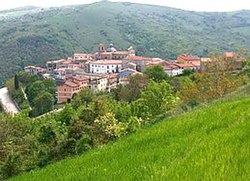Faeto | |
|---|---|
| Comune di Faeto | |
 | |
| Coordinates: 41°19′30″N 15°9′39″E / 41.32500°N 15.16083°E | |
| Country | Italy |
| Region | |
| Province | Foggia (FG) |
| Area | |
| • Total | 26.19 km2 (10.11 sq mi) |
| Elevation | 820 m (2,690 ft) |
| Population (31 December 2003)[2] | |
| • Total | 719 |
| • Density | 27/km2 (71/sq mi) |
| Demonym | Faetani[citation needed] |
| Time zone | UTC+1 (CET) |
| • Summer (DST) | UTC+2 (CEST) |
| Postal code | 71020 |
| Dialing code | 0881 |
| ISTAT code | 071023 |
| Patron saint | San Prospero |
| Saint day | Second Sunday in August |
| Website | Official website |
Faeto (Arpitan: Fayéte, IPA: [faˈjet]) is a town and comune in the province of Foggia in the Apulia region of southeast Italy.
It is a mountain village lying astride the Apennines and renowned for its prosciutto, an Italian dry-cured ham known as prosciutto di Faeto. Residents of Faeto and neighbouring Celle di San Vito are speakers of Faetar, a daughter language of the Franco-Provençal language, which is found in an Alpine region spanning northwestern Italy, southeastern France and southwestern Switzerland. Faeto was also historically inhabited by Arbëreshë community, but these have since assimilated.[3]
Faeto borders the following municipalities: Biccari, Castelfranco in Miscano, Celle di San Vito, Greci, Orsara di Puglia, Roseto Valfortore.
References[edit]
- ^ "Superficie di Comuni Province e Regioni italiane al 9 ottobre 2011". Italian National Institute of Statistics. Retrieved 16 March 2019.
- ^ All demographics and other statistics from the Italian statistical institute (Istat)
- ^ Gjovalin Shkurtaj, Shpirti i arbrit rron



Well, that’s interesting to know that Psilotum nudum are known as whisk ferns. Psilotum nudum is the commoner species of the two. While the P. flaccidum is a rare species and is found in the tropical islands. Both the species are usually epiphytic in habit and grow upon tree ferns. These species may also be terrestrial and grow in humus or in the crevices of the rocks.
View the detailed Guide of Psilotum nudum: Detailed Study Of Psilotum Nudum (Whisk Fern), Classification, Anatomy, Reproduction